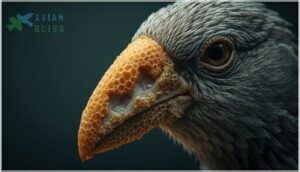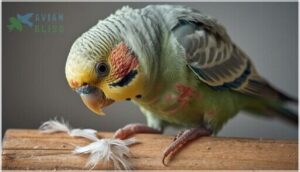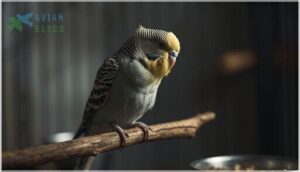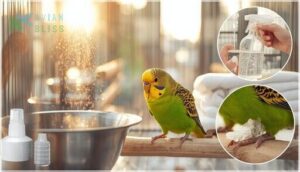This site is supported by our readers. We may earn a commission, at no cost to you, if you purchase through links.
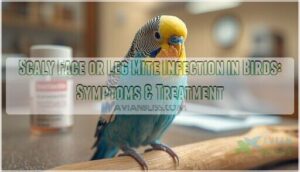
These microscopic pests tunnel into your bird’s skin, creating those distinctive scaly lesions that spread fast when birds come into direct contact with each other.
Budgies and parakeets get hit hardest by these mites – outbreaks can infect up to 80% of birds in a flock.
But here’s the silver lining: treatments like ivermectin work really well against these parasites, especially when you pair the medication with a deep clean of their cage.
Table Of Contents
- Key Takeaways
- What Causes Scaly Face and Leg Mites?
- Bird Species Most Commonly Affected
- Recognizing Symptoms of Mite Infection
- How Scaly Face and Leg Mites Spread
- Diagnosing and Treating Mite Infections
- Preventing and Managing Re-Infection
- Frequently Asked Questions (FAQs)
- How do you treat scaly face mites in birds?
- How do you treat scaly face and leg mites?
- What causes scaly face in birds?
- How do you treat scaly feet in birds?
- Can scaly face or leg mites infect other pets?
- How long does it take for scaly face mites to heal?
- Are scaly face or leg mites contagious to humans?
- Can scaly face or leg mites be prevented with nutrition?
- Can humans catch scaly mites from birds?
- How long does mite treatment typically take?
- Conclusion
Key Takeaways
- Early detection saves lives – Watch for crusty, honeycomb-like patches on your bird’s beak, cere, or feet, as these distinctive lesions signal Knemidocoptes pilae mite infection that requires immediate veterinary attention.
- Professional treatment works best – Your vet will confirm the diagnosis through skin scrapings and prescribe antiparasitic medications like ivermectin, which achieve over 90% success rates when combined with proper cage disinfection.
- Prevention beats treatment – Regular cage cleaning, weekly disinfection, and isolating new birds prevent mite spread, since these parasites survive in contaminated environments and spread through direct bird-to-bird contact.
- Complete environmental management is essential – Treating only your bird won’t work since mites can hide in cage crevices for months, so you must replace porous materials like wooden perches and thoroughly disinfect all surfaces to prevent reinfection.
What Causes Scaly Face and Leg Mites?
Tiny mites called Knemidocoptes pilae cause scaly face and leg problems in birds.
These microscopic parasites tunnel under the skin around the beak, cere, and feet, creating the characteristic crusty appearance.
Mites pass from bird to bird through direct contact and love crowded aviaries where multiple birds live together. Young birds and budgerigars are especially vulnerable to picking up these infections.
Knemidocoptes Species and Life Cycle
These tiny troublemakers might be microscopic, but they pack a punch that can turn your bird’s beautiful beak into a crusty, honeycomb nightmare. Knemidokoptes pilae, the sarcoptid mite behind this mess, spends its entire lifecycle burrowing through your bird’s skin.
These host-specific parasites complete their development in about two weeks, with females creating tunnels that cause those telltale scaly lesions you’ll notice first.
How Birds Become Infected
Your bird doesn’t just wake up one morning with scaly mites crawling across its face – these microscopic hitchhikers need a way to jump from one feathered host to another.
These tiny parasites spread in a few key ways:
- Direct Contact between infected and healthy birds during preening or feeding
- Environmental Spread via contaminated perches, cages, and feeding stations
- Mite Vectors like wild birds introducing parasites to domestic flocks
- Genetic Factors affecting individual immunity levels and susceptibility
- Disease transmission through shared nesting materials and close quarters
Your bird’s exposure doesn’t guarantee infection – some birds naturally resist these parasites better than others.
Risk Factors and Susceptible Species
A few key things make your bird more likely to get scaly face and leg mites. Genetics is huge here—young birds and those from inbred lines get hit hardest.
Environmental stressors like overcrowding, recent relocation, or poor hygiene create perfect conditions for outbreaks. Breed susceptibility varies considerably: parakeets and budgerigars face infection rates up to 80% during outbreaks, while cockatiels and lovebirds also rank high-risk.
Social influences matter too—highly social bird species experience more transmission through close contact between birds. The mites are transmitted via close contact between birds.
Bird Species Most Commonly Affected
While scaly face and leg mites can affect many bird species, some are hit harder than others. Parakeets, cockatiels, lovebirds, and canaries top the list of commonly infected pet birds, with young birds facing the highest risk.
Parakeets (Budgies)
Budgerigars face the highest risk among pet birds, accounting for over 80% of scaly face mite cases worldwide. These popular parakeets show visible Knemidokoptes lesions in 13-30% of captive populations, with budgie outbreak factors creating recurrence rates exceeding 40% in breeding facilities.
Budgie colony infestation can affect up to 66% of enclosed populations, though budgie genetic resistance varies considerably between individual birds requiring ivermectin treatment. These mites primarily affect the bird’s integumentary system.
Cockatiels, Lovebirds, and Canaries
Beyond budgerigars, cockatiels, lovebirds, and canaries make up roughly 65% of remaining psittacine mite diagnoses. These popular pet birds face significant infection risks, with cockatiel aviary surveys showing 18-21% prevalence rates. Breeding population rates tell an alarming story about how quickly scaly face mites can spread through collections.
- Lovebird mite prevalence reaches 12% annually in breeding facilities, primarily from Procnemidocoptes janssensi
- Canary mite infections account for 72% of reported cases, with Knemidocoptes mutans as the main culprit
- Mixed-species aviaries see up to 46% of canaries testing positive during outbreak cycles
- Treatment of scaly face mites requires immediate veterinary intervention to prevent colony-wide spread
Other Wild and Domestic Birds
Wild and domestic birds commonly get knemidokoptic mange, affecting species well beyond typical pets.
About 22% of backyard chicken flocks deal with these infestations. Raptors are hit particularly hard during outbreaks, with morbidity reaching dangerous levels.
Robin outbreaks have shown 60-80% infection rates across southern states. Blackbird prevalence varies from 0.6-4% in field studies.
The devastating eagle outbreak in California achieved 100% infection with 66% mortality, demonstrating how these avian diseases impact diverse bird species requiring specialized veterinary medicine and treatment options.
Recognizing Symptoms of Mite Infection
Catching scaly face and leg mites early makes all the difference for your bird’s health.
You’ll notice distinctive crusty, honeycomb-like lesions forming on your bird’s beak, cere, legs, and sometimes around the eyes as these microscopic parasites burrow into the skin.
Scaly, Crusty Lesions on Beak and Legs
When you notice scaly face or scaly leg mites on your bird, the skin lesions create distinct honeycomb patterns that look like tiny tunnels burrowing through the beak and feet. These crusty formations start as whitish patches but progress to thick, gray-yellow encrustations.
Severe cases cause ulceration risk and mobility impairment, with some birds developing tassel-foot deformities requiring immediate mite treatment.
Feather Loss and Irritation
While crusty scales grab your attention first, the mites don’t stop there—they’ll keep burrowing and irritating your bird’s delicate skin until feathers start falling out around the affected areas.
You’ll notice patchy feather loss, especially around the cere and legs, where constant scratching from bird mites creates skin inflammation and dermatitis. This isn’t normal molting—it’s your bird desperately seeking itch relief through destructive feather plucking behaviors.
Weight Loss and Behavior Changes
When mites take over your bird’s body, they don’t just attack the skin—they drain your feathered friend’s energy and spirit, leading to noticeable weight loss and dramatic changes in behavior.
You’ll notice decreased appetite as your bird struggles with discomfort, along with lethargy signs that replace their usual chirpy energy. Social isolation becomes common as stress indicators mount, and some birds develop feather plucking habits when clinical disease progresses.
How Scaly Face and Leg Mites Spread
These tiny parasites jump from bird to bird mainly through direct contact.
Scaly face and leg mites can also hang around in dirty cages and equipment, waiting to latch onto birds that are already stressed or sick.
Direct Bird-to-Bird Contact
Picture a crowded bird cage where one infected budgie can turn into a nightmare scenario for every feathered friend nearby—that’s exactly how scaly face and leg mites spread through direct contact between birds. Social bird behavior creates perfect conditions for mite transmission, especially when birds share perches or engage in preening activities.
The mite transmission rate increases dramatically in flocks with poor flock immunity dynamics, making quarantine effectiveness essential for preventing widespread ectoparasites outbreaks.
Environmental Contamination
Your bird’s cage can harbor these invisible troublemakers long after you’ve treated the infection, turning a clean-looking environment into a reinfection factory.
Mites can survive on perches, toys, and food bowls for weeks, creating reservoir hosts for disease transmission.
Even wild bird spread through contaminated surfaces makes cage disinfection essential.
Without proper mite treatment of the environment, secondary infections become inevitable despite successful bird treatment.
Genetic Predisposition and Immunity
Some birds seem to have a built-in shield against these tiny invaders, while others practically roll out the welcome mat for mite infestations. Your bird’s immune response plays a key role in disease prevention, with certain genetic markers influencing breed susceptibility.
- Natural resistance varies dramatically between individual birds and species
- Inherited immunity can make some birds nearly mite-proof while others struggle
- Immune system strength directly impacts how well your bird fights off avian disease
Understanding these genetic factors helps explain why multiple birds exposed to mites don’t all develop infections.
Diagnosing and Treating Mite Infections
Before you can treat scaly face or leg mites, you need to know for sure that’s what you’re dealing with. Your vet will scrape a bit of skin to check for Knemidokoptes mites under the microscope.
Once confirmed, they’ll likely prescribe ivermectin and walk you through cleaning your bird’s cage thoroughly to prevent reinfection.
Confirming Diagnosis With Skin Scrapings
Diagnosing scaly face mites isn’t as simple as spotting crusty scales on your bird’s beak—you’ll need concrete proof these microscopic troublemakers are actually there. Your veterinarian will perform skin scrapings from affected areas for microscopic examination.
Sample collection requires expertise, as false negatives can occur if mites burrow deep. Proper mite identification confirms the diagnosis of knemidokoptic mange, guaranteeing accurate treatment.
Ivermectin and Other Antiparasitic Treatments
After confirming mites through skin scrapings, your veterinarian will prescribe an antiparasitic drug like ivermectin. This powerful mite treatment usually involves applying a single drop of 0.1% ivermectin solution directly to your bird’s skin, repeated weekly for two weeks.
Moxidectin offers another effective option, while newer treatments like fluralaner show promising results with 99% mite eradication rates.
Cage Cleaning and Environmental Disinfection
Treating your bird is only half the battle – those stubborn mites can lurk in cage crevices for months, just waiting to reinfect your feathered friend.
You’ll need to disinfect everything weekly during treatment using bird-safe products that eliminate ectoparasites without harming caged birds. Replace porous materials like wooden perches, since proper mite control requires removing hiding spots where these parasites survive between treatments.
Home Remedies: Vaseline and Barrier Creams
While veterinary treatment remains the best course of action, some bird owners wonder if petroleum jelly can offer temporary relief for their feathered friend’s crusty, irritated skin. Vaseline can provide short-term comfort by softening scales, but it won’t eliminate the underlying mite infestation.
Apply thin layers to affected areas, avoiding the nostrils. However, cream application alone can’t replace proper antiparasitic medication for effective scaly mite treatment.
Preventing and Managing Re-Infection
After beating a mite infection, the real battle becomes preventing those little troublemakers from staging a comeback.
The key lies in creating a clean environment and staying vigilant for any early warning signs that could signal trouble ahead.
Regular Bird and Cage Hygiene
Think of cage hygiene as your bird’s first line of defense against these tiny invaders that love to set up camp in dirty environments. Regular cage sanitation prevents mite infestation by removing the debris and moisture that parasitic infections thrive on, keeping your feathered friend healthy.
- Weekly deep cleaning – Scrub cage bars, replace bedding, and disinfect all surfaces to eliminate mite eggs
- Daily water changes – Fresh, clean water prevents bacterial growth that weakens bird health and immunity
- Perch maintenance – Wash and rotate perches regularly to remove mite debris and prevent disease transmission
- Toy disinfection – Clean toys weekly with bird-safe disinfectant to stop bird mites from hiding in crevices
Isolating Infected Birds
When you spot those telltale crusty scales on your bird’s face or legs, your first instinct might be to keep them close for comfort. However, isolation is actually your most powerful weapon against spreading the infection.
Set up a separate cage in a quiet area to reduce stress while preventing disease transmission to healthy birds. This quarantine duration should last until treatment eliminates the mite infestation completely.
Monitoring and Early Veterinary Intervention
Regular monitoring helps catch symptoms of scaly face and scaly leg before they become severe. Weekly visual inspections of your bird’s beak, legs, and cere allow for early detection, and formal training in symptom recognition increases correct identification by over 60%. Veterinary protocols emphasize prompt intervention within two weeks of symptom onset for best treatment outcomes:
- Check for crusty buildup or skin texture changes during routine handling
- Schedule monthly thorough health checks to reduce severe infection rates
- Contact your veterinarian immediately if you notice any lesions or behavioral changes
Early management through proper veterinary treatment achieves clinical resolution in over 90% of cases, while training outcomes show educated bird owners reduce consultation delays noticeably. Long-term surveillance and diagnosis of scaly face and leg disease require ongoing partnerships between owners and veterinarians.
Frequently Asked Questions (FAQs)
How do you treat scaly face mites in birds?
Your vet will likely prescribe antiparasitic medications like ivermectin to knock out those Knemidocoptes pilae mites.
Professional veterinary care ensures proper diagnosis through skin scrapings, while cage disinfection prevents reinfection.
Home remedies aren’t recommended as primary treatment.
How do you treat scaly face and leg mites?
Fighting off these tiny pests takes a two-part strategy: getting the right meds from your vet and cleaning house at home.
Drugs like ivermectin or moxidectin will knock out the mites, but you’ll also need to deep-clean that cage to stop them from coming back.
What causes scaly face in birds?
Scaly face develops when tiny burrowing mites called Knemidocoptes pilae infect your bird’s skin, creating those characteristic crusty lesions you’re worried about.
- Mite species – Knemidocoptes pilae burrows into skin cells, causing inflammation and thick scale formation
- Transmission vectors – Direct contact with infected birds spreads mites through close interaction or shared perches
- Bird immunity – Young birds and stressed adults show higher susceptibility to mite colonization
- Environmental factors – Poor cage hygiene and overcrowding create ideal conditions for mite survival
- Genetic links – Some bird bloodlines demonstrate inherited weakness against Knemidocoptes pilae infections
How do you treat scaly feet in birds?
Your bird’s scaly feet need swift veterinary action, like a firefighter rushing to a blaze. Antiparasitic medications, particularly ivermectin, eliminate these burrowing mites effectively under veterinary oversight.
Supportive care includes cage disinfection and paraffin oil applications for home treatment relief.
Can scaly face or leg mites infect other pets?
 View On Amazon
View On Amazon - Knemidokoptes mites evolved specifically for bird skin and feather environments
- Mammalian susceptibility remains minimal due to different skin structures and temperatures
- Human risk factors are virtually nonexistent with proper hygiene
- Mange mites affecting mammals are generally different species entirely
How long does it take for scaly face mites to heal?
Following proper antiparasitic treatment, scaly face mites usually heal within 4-6 weeks, though healing signs appear gradually.
Treatment duration depends on infection severity, while follow-up care prevents re-infection risk and minimizes scarring potential from these persistent parasites.
Are scaly face or leg mites contagious to humans?
Fortunately, scaly face and leg mites from birds don’t usually infect humans. These avian ectoparasites show limited zoonotic potential, as they’re highly host-specific.
However, some bird mites can carry disease-causing organisms, creating potential public health concerns through indirect transmission routes.
Can scaly face or leg mites be prevented with nutrition?
An ounce of prevention is worth a pound of cure” rings especially true for avian health. Nutritional deficiencies don’t directly prevent scaly face mites, but proper diet strengthens your bird’s natural defenses against these parasites.
You know how they say good nutrition is your best defense? That’s spot-on when it comes to bird health.
Sure, a solid diet won’t magically shield your bird from scaly face mites, but it does something just as important—it builds up their natural immunity to fight off these pesky parasites.
- Probiotic Influence from fermented foods boosts gut health and overall immunity
- Diet Impact includes fresh vegetables that provide essential nutrients for feather and skin health
- Supplement Benefits like omega-3 fatty acids reduce inflammation and aid healing
- Bird health issues often stem from poor nutrition, making balanced diets vital for preventing avian mange
While good nutrition won’t stop mite transmission and susceptibility entirely, it gives your feathered friend the best fighting chance against bird skin diseases and other avian health problems.
Can humans catch scaly mites from birds?
Zoonotic potential remains remarkably low for avian mange. Human susceptibility to Knemidokoptes mites is virtually nonexistent, as these parasites are highly species-specific and can’t establish infections on human skin.
Don’t worry about catching avian mange from your birds. These mites are picky eaters—they only go after birds, not humans. Your skin just isn’t what they’re looking for.
| Transmission Risk | Human Impact |
|---|---|
| Direct contact | No documented cases |
| Shared environment | Minimal concern |
| Handling infected birds | Safe with basic hygiene |
| Cage cleaning | No transmission risk |
While these mites jump between birds pretty easily, they won’t cause any skin problems for you. Think of it like trying to use a bird-specific key on a human lock—it just doesn’t fit.
There’s really no public health worry here. Still, washing your hands after handling birds is always smart—just good hygiene practice.
How long does mite treatment typically take?
Most Treatment Duration spans 2-4 weeks with proper Ivermectin Timeline protocols.
Complete Recovery depends on infection severity, Treatment Methods used, and your bird’s immune response to thorough Diagnosis and treatment of scaly face mites.
Conclusion
Like knights of old donning armor against invisible foes, you must act swiftly when spotting those telltale crusty patches on your feathered friend. Scaly face or leg mite infection in birds won’t disappear on its own, but proper veterinary treatment with ivermectin combined with thorough cage cleaning creates an effective battle plan.
When scaly mites attack your bird’s beak and feet, swift veterinary treatment with proper cage cleaning creates the winning battle plan
Early detection and consistent treatment protocols help your bird return to peak health while preventing spread to other birds in your flock.
- https://bioone.org/journals/the-auk/volume-134/issue-3/AUK-16-134.1/Negative-effect-of-mite-Knemidokoptes-infection-on-reproductive-output-in/10.1642/AUK-16-134.1.full
- https://tricolor.ice.ucdavis.edu/sites/g/files/dgvnsk3096/files/inline-files/Clarketal2019-Knemidokoptesmites.pdf
- https://pmc.ncbi.nlm.nih.gov/articles/PMC9897498/
- https://www.sciencedirect.com/topics/veterinary-science-and-veterinary-medicine/knemidokoptes
- https://www.cacklehatchery.com/dealing-with-scaly-leg-mites-in-chickens/


